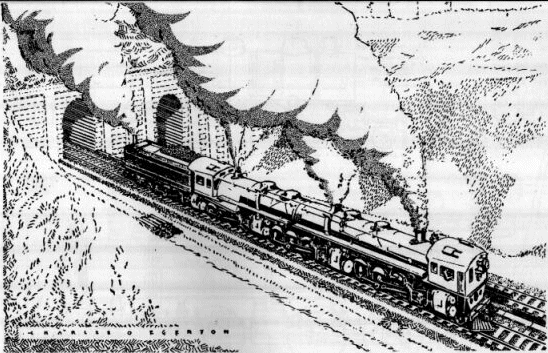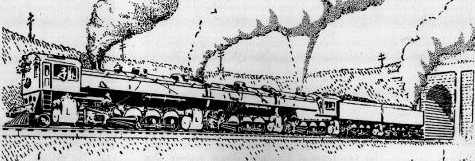A machine of this length could not be built with a rigid boiler, so note the bellows connection in the middle. This notion was not specific to the Quadruplex- see Flexible Mallets for another example. In engineering terms, this sort of technique is called "Asking For Trouble". There were two separate boilers, one on each side of the bellows joint.
The locomotive was a compound, with cylinders operating at only two pressures; the HP cylinders 7 on the drawing above were fed from the forward boiler and worked at high pressure, a horizontal pipe taking the exhaust from 7 to 8 which worked at low pressure. HP cylinders 9 were fed from the rear boiler and exhausted through another horizontal pipe to LP cylinders 10. (The designer very sensibly avoided the temptation to go for quadruple-expansion, as used in some marine steam engines) The draught was provided not by an exhaust steam blast, but by a steam-turbine driven fan driven 26 exhausting through the funnel 19. The exhaust steam from the LP cylinders went straight to atmosphere via the funnels 33 and 38.
Henderson recognised that forward vision wouldn't be too good if you had to squint along the length of such a boiler, so the loco was a cabforward design. The driver was to communicate with the fireman at the back by means of a voicepipe; it is difficult to see that working well with effectively four steam locomotives at once adding to the ambient noise.
The Baldwin Locomotive Company seriously intended to build this monster, but after it became clear that the Triplexes were failures there were (perhaps fortunately) no customers.

Above: A contemporary drawing of the Baldwin 2-8-8-8-8-2 Quadraplex. Taken from a book published in Santiago, Chile, in 1918. It is not just a copy of the patent drawing.
 |
| Left: An artist's impression of the 2-8-8-8-8-2 Baldwin Quadraplex
From Trains, date unknown.
|
 |
| Left: An artist's impression of the 2-8-8-8-8-2 Baldwin Quadraplex in action
The design was envisioned by George Henderson of the Baldwin Company in 1913.
From Trains, date unknown.
|
THE BALDWIN QUINTUPLEX
Henderson also proposed what he called a Quintuplex:

Above: An artist's impression of the 2-8-8-8-8-8-2 Baldwin Quintuplex proposal.
From Trains, date unknown.
 |
| Left: Artist's impression of the final development of these proposals: a 2-10-10-10-10-10-2 Baldwin Quintuplex in action!
From Trains, date unknown.
|














